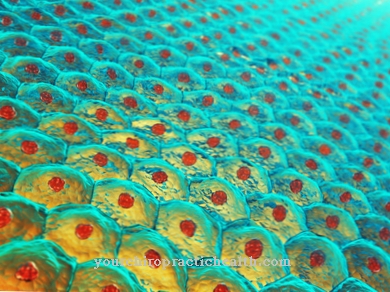The Remineralization is the re-storage of minerals in hard tissue, such as teeth or bones. Overacidification causes hard tissue to demineralize and thus become brittle. In the mouth, the saliva is responsible for remineralization, which is itself oversaturated with minerals.
What is remineralization?

The teeth and bones of humans consist of inorganic parts. These inorganic substances are the minerals. Calcium and phosphate in particular are found in the hard substances in the body.
Mineralization is therefore a crucial step in the formation of these hard tissues. In medicine, this means the gradual storage of minerals in teeth and bones. In the oral cavity in particular, however, the hard tissue naturally demineralizes every day. Inorganic substances are released from the hard substances again as part of this demineralization. This happens either through the body's own acids, such as stomach acid, or through acidic foods.
In the mouth, the saliva takes on a buffer function during demineralization. The secretion ensures that the teeth are not completely demineralized. Saliva neutralizes acids and thus protects the mineral balance of the teeth. A balanced alternation between remineralization and demineralization takes place in the mouth. Accordingly, medicine understands remineralization to mean the re-storage of minerals in hard tissue, as guaranteed in the mouth by saliva.
Function & task
Mineralization is a crucial process for the development of hard tissue. In teeth, mineralization is the hardening process of tooth enamel and dentin. Thanks to this mineralization, the teeth are robust and relatively break-proof. The same applies to the mineralization of the bones. Without the minerals, the bone substance would be brittle and threatened with fractures. The remineralization thus preserves the mineral content in hard tissues and ensures that the resistance of these tissues is maintained.
The saliva plays an important role in the remineralization of decalcified teeth. Saliva is made up of water, proteins, and minerals such as calcium and phosphate. Demineralized teeth can insert these minerals like small building blocks into decalcified areas and thus maintain the protective tooth enamel.
It is thanks to the proteins in the saliva that the minerals do not break down prematurely during installation. The proteins also ensure that not too many minerals are bound to the teeth. They clean the surfaces of the teeth like a biochemical toothbrush.
The fact that sugar-free chewing gum is said to have an effect on dental hygiene is due, for example, to its stimulating effect on the salivary glands.
The saliva is a solution made up of perfectly coordinated individual components that work together to ensure the health of the teeth. The teeth bathe, so to speak, in a bath that is oversaturated with minerals and can thus repair minor mineral losses and compensate for acid attacks through the storage of minerals. In this way, demineralization and remineralization are kept in balance in the mouth of a healthy person.
The balance between demineralization and remineralization can, however, be threatened by various dietary habits, such as excessive consumption of acidic beverages or other foods. Oral hygiene with substances containing fluoride can restore the equilibrium, should it be lost, and support remineralization.
Illnesses & ailments
With regard to the teeth, tooth decay is probably the most common symptom of insufficient remineralization. Tooth decay occurs in patients with hyposalivation, among others. This means the lack of secretion of saliva, which is a natural process especially in old age. The salivary glands reduce their activity with age. Dry mouth occurs and the saliva loses its buffer function and in extreme cases even changes its composition.
The less saliva there is in the mouth, the less the body can compensate for the natural decalcification of the teeth. Only the saliva and its remineralizing functions guarantee that people retain their teeth into old age.
In the case of bones, a lack of remineralization can in turn lead to diseases such as osteoporosis. With this phenomenon, the bone substance gradually decalcifies. Those affected suffer more often from fractures and their bones are hardly flexible any more. The mechanism of osteoporosis is not yet fully understood. However, dietary habits probably play a role in the clinical picture that should not be underestimated.
Missing or insufficient remineralization can also be due to general deficiency symptoms in the organism. The lack of supply of minerals and a wrong balance in the composition of the nutrients can play a role in this context. In order to remineralize the bones, the body not only needs minerals, but also vital substances and vitamins such as vitamin D. If one of these substances is only available in insufficient quantities in the organism, there are disturbances in the compensation of acid attacks.
A reduced absorption of minerals in the intestine can also lead to insufficient remineralization. This phenomenon can occur in the context of various intestinal diseases or, for example, in intestinal inflammation caused by the autoimmune disease Crohn's disease.
Metabolic diseases can also be responsible for disorders of remineralization. In the case of a misdirected calcium-phosphate metabolism, for example, the body's own hard tissue increasingly decalcifies.













.jpg)

.jpg)
.jpg)











.jpg)